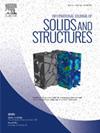Statistical volume element generation for paperboard based on X-ray computer tomography images
IF 3.4
3区 工程技术
Q1 MECHANICS
International Journal of Solids and Structures
Pub Date : 2025-05-22
DOI:10.1016/j.ijsolstr.2025.113446
引用次数: 0
Abstract
The macroscopic response governed by a statistical volume element, generated from 3D X-ray computer tomography images of paperboard, is explored. The statistical volume element, which consists of fibres and void, is derived from X-ray computer tomography images. Two filters for computing intensity fields and intensity gradients have been implemented and compared. Using an intensity threshold, the fibres are identified. The intensity gradient is used to identify the structural tensors, which define the fibre orientations. A finite element model is established using the voxel structure from the X-ray computer tomography images. Fibres are modelled as a transversely isotropic elasto-plastic material, where use is made of the identified structural tensors. From finite element simulations of statistical volume elements, calibrated against macroscopic uniaxial responses, the elasto-plastic fibre properties are identified, and the stress distribution in the volume element is analysed. A study on the dimensions of the volume element is also conducted.
基于x射线计算机断层扫描图像的纸板统计体元生成
由统计体积元控制的宏观响应,由三维x射线计算机断层扫描图像生成纸板,进行了探索。由纤维和空隙组成的统计体积元来源于x射线计算机断层扫描图像。对计算强度场和强度梯度的两种滤波器进行了实现和比较。使用强度阈值,识别纤维。强度梯度用于识别结构张量,结构张量定义纤维取向。利用x射线计算机断层图像的体素结构建立了有限元模型。纤维被建模为横向各向同性弹塑性材料,其中使用已识别的结构张量。通过统计体积元的有限元模拟,根据宏观单轴响应进行校准,识别了纤维的弹塑性性能,并分析了体积元中的应力分布。对体积元的尺寸进行了研究。
本文章由计算机程序翻译,如有差异,请以英文原文为准。
求助全文
约1分钟内获得全文
求助全文
来源期刊
CiteScore
6.70
自引率
8.30%
发文量
405
审稿时长
70 days
期刊介绍:
The International Journal of Solids and Structures has as its objective the publication and dissemination of original research in Mechanics of Solids and Structures as a field of Applied Science and Engineering. It fosters thus the exchange of ideas among workers in different parts of the world and also among workers who emphasize different aspects of the foundations and applications of the field.
Standing as it does at the cross-roads of Materials Science, Life Sciences, Mathematics, Physics and Engineering Design, the Mechanics of Solids and Structures is experiencing considerable growth as a result of recent technological advances. The Journal, by providing an international medium of communication, is encouraging this growth and is encompassing all aspects of the field from the more classical problems of structural analysis to mechanics of solids continually interacting with other media and including fracture, flow, wave propagation, heat transfer, thermal effects in solids, optimum design methods, model analysis, structural topology and numerical techniques. Interest extends to both inorganic and organic solids and structures.

 求助内容:
求助内容: 应助结果提醒方式:
应助结果提醒方式:


